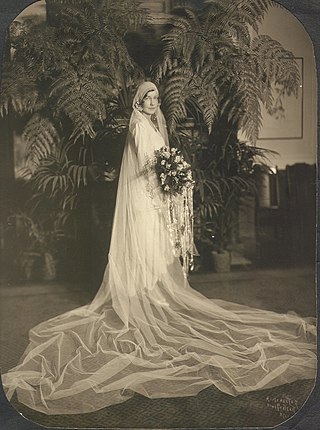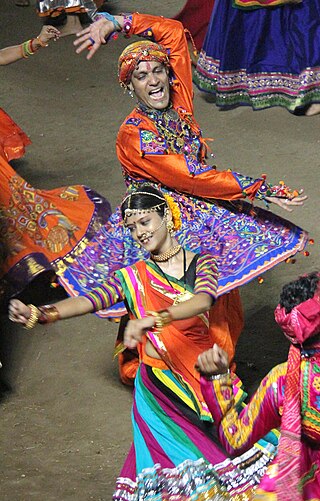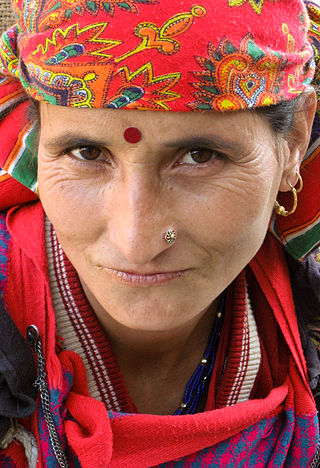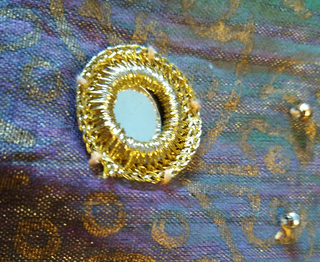
Choora (in Hindi-Urdu) or Chuda or Chudlo [1] (in Gujarati) is a set of bangles traditionally worn by a bride on her wedding day and for a period after, especially in Indian weddings.

Choora (in Hindi-Urdu) or Chuda or Chudlo [1] (in Gujarati) is a set of bangles traditionally worn by a bride on her wedding day and for a period after, especially in Indian weddings.
The choora is usually red and white; sometimes the red bangles are replaced with another colour, but they are usually only two colours. They are traditionally made of ivory, [2] with inlay work, though now made with plastic. [3] Traditionally there are 21 bangles, [4] although more recently the bride often wears 7, 9 or 11 bangles. [5] The bangles range in size according to the circumference of the top of the forearm and the wrist end so that the set fits neatly.
In Gujarati tradition, the bridal bangles are referred to as Chudlo (ચૂડલો). [1] Traditionally they were made using elephant's tusks/ivory and were known as "Haathi Daant no Chudlo". These bangles are gifted to the bride by her maternal uncle "Maama".
Chudlo is generally paired with Gujarati bridal saree known as Panetar. These Chudlo bangles are generally red and green in color to match the PanetarSaree. Chudlo has great significance in Gujarati culture as is evident several folk songs like "Chudlo Lyado Ji Meera Bai Pehar Lyo" and " Radha Chudlo Perje Mara Naam Nu". [6]
Hirva Chuda, peacock green colored Chuda bangles are preferably worn by Marathi brides. The green is the color of fertility and is associated with Devi (Hindu Goddess). In the Devi shrines of Tuljabhavani and Renukadevi, the Goddesses are adorned using Hirva Chuda. The Marathi tradition of Hirva Chuda during marriage is akin to wearing green bangles during Hariyali Teej in North India. Sometimes, green bangles are also paired with red bangles. The hirva chuda (green bangles) are worn after the haldi oil bath, given by a suvasini and are worn for a year. [7]
Chooda is often spelled as Chura [8] in Nepali. A Nepali chura set is usually made of red colored gilded bangles. Chura bangles are often paired with pote (beaded necklace). [9] Chura bangle sets are also worn during Teej celebrations as is evident from Nepali Teej songs like Chura Tika Laali.
In Odia & Bengali marriages, brides wear red and white set of bangles which are made from sea shell (shankh) and red coral (pola). Thus, Shakha are white bangles made through conch-shell and Pola are red bangles made by red corals. Loha, a large iron bangle covered with gold is also worn along with Shakha Pola Chuda. [10]
The Muthi Kharu is a traditional and ethnic bangle worn in marriages by the bride also while celebrating Bihu festival in Assam extensively. It has a golden layer and silver in some parts making it more attractive. [11]
Sindhi traditional Churas were made of ivory and seashells, but today it is made of plastic of different colors like red, blue, green, orange etc are also used unlike traditionally it was only of white color. Ivory was used to make many jewelries, the Bhambhore city had the biggest ivory workshop in the world. [12] [13]
In Sindh the traditional Churas were rings of ivory covering the fore arms or full arms, [14] these were worn by all sects, religions and classes but unlike other parts of India these were not worn as wedding symbol, as unmarried women would also wear Churas, perhaps only till forearms. [15]
There are three different styles/types of such Churas worn in Sindh first are Sindhi style, Dhatki style and Marwari style. The traditional Churas have been completely abandoned by many Sindhi women of Sindh today and have adopted wearing the red colored Churas made of glass worn usually by bride only on the wedding ceremony, for others glass bangles or silver or gold Kangar/Kara (bracelets) are worn. But many women of Thar still continue to wear the ancient Sindhi Churas.
Wearing the chooda is primarily an Indian Hindu tradition which is also followed by other Indian religious communities culturally. Sindhoor and Mangalsutra — are other adornments worn by married women. The custom is widely observed in Jammu, Himachal, [16] Punjab, Uttarakhand, Haryana, Gujarat, Rajasthan [17] [18] and Madhya Pradesh, Uttar Pradesh. [19] [4] The chooda ceremony [19] is held on the morning of the wedding or the day before. [2] The bride's maternal uncle and aunt give her a set of choodiyan.
Traditionally, the bride would wear a chooda for a full year, [20] although if a newly wed bride became pregnant before her first anniversary, the choora was taken off. When the color started to fade, her in-laws would actually have it re-colored, so everyone would know that she had been married for less than a year. [21] On an auspicious holiday, usually sankranti , after the first anniversary her in-laws would hold a small intimate ceremony in which the choora was removed and glass choodiyan (bangles) were placed on both hands. This usually was accompanied with mithai (Indian sweets) and a monetary shagun. The chooda then was taken to a river and a prayer was said and it was left to float onto the water. Afterwards the woman could wear other chooda in any colour for as long as she liked.
It is now normal for the bride to wear her chooda for a month and a quarter (40 days). As the chooda is made of fragile materials, Indian custom has it that the bride may refrain from heavy housework in her marital home to keep it intact for the 40 days, as a kind of honeymoon. After that, in traditional homes at least, she takes over the lion's share of domestic work from her mother-in-law. [22]

A bride is a woman who is about to be married or who is a newlywed.

A wedding dress or bridal gown is the dress worn by the bride during a wedding ceremony. The color, style and ceremonial importance of the gown can depend on the religion and culture of the wedding participants. In Western culture, the wedding dress is most commonly white, a fashion made popular by Queen Victoria when she married in 1840. In Eastern cultures, brides often choose red to symbolize auspiciousness.
Visual markers of marital status, as well as social status, may include clothing, hairstyle, accessories, jewelry, tattoos, and other bodily adornments. Visual markers of marital status are particularly important because they indicate that a person should not be approached for flirtation, courtship, or sex. In some cultures, married people enjoy special privileges or are addressed differently by members of the community.
Bangles are traditionally rigid bracelets which are usually made of metal, wood, glass or plastic. These ornaments are worn mostly by women in the Indian subcontinent, Southeastern Asia, the Arabian Peninsula, and Africa. It is common to see a bride wearing glass bangles at weddings in India, Bangladesh, Pakistan, Nepal, Sri Lanka and in other Asian countries. Bangles may also be worn by young girls, and bangles made of gold or silver are preferred for toddlers. Some men and women wear a single bangle on the arm or wrist called kada or kara.

Garba is a form of Gujarati dance which originates from the state of Gujarat, India. The name is derived from the Sanskrit term Garbha. Many traditional garbas are performed around a centrally lit lamp or a picture or statue of the Hindu goddess Durga. Traditionally, it is performed during the nine-day Hindu festival Navaratri. Either the lamp or an image of the Goddess, Durga is placed in the middle of concentric rings as an object of veneration.

A bindi known as pottu and teep is a coloured dot or, in modern times, a sticker worn on the center of the forehead, originally by Hindus, Jains and Buddhists from the Indian subcontinent.

A mangala sutra, or tali, is a necklace that the groom ties around the bride's neck in the Indian subcontinent, in a ceremony called the Mangalya Dharanam during a Hindu wedding. The necklace serves as a visual marker of status as a married Hindu woman.

Punjabi wedding traditions are a strong reflection of Punjabi culture with ritual, song, dance, food, and dress that have evolved over centuries.

Mayian, also known as Maiyun, Haldi, or Ubtan, is the term used for the preparation ceremony one day before Punjabi weddings of India and Pakistan. This ceremony is a late afternoon or early evening festival, at the couple's parental homes. It consists of many rites, including the Batna, Choora, Jaggo, fireworks and sometimes the ladies Sangeet and mehndi. In South Indian weddings a similar ceremony takes place called the "Pithi" ceremony.

Ghagra choli is a type of ethnic clothing for women from the Indian Subcontinent, notably in the Indian states of Rajasthan, Gujarat, Madhya Pradesh, Uttar Pradesh, Bihar, Haryana, Punjab, Himachal Pradesh, Uttarakhand, Jammu and Kashmir, as well as in the Pakistani provinces of Punjab and Sindh. In Punjab, the lehenga is traditionally worn with a kurti. It is a combination of the gagra or lehenga and the choli (blouse), however in contemporary and modern usage lehenga choli is the more popular and widely accepted term by fashion designers, trend setters, and boutiques in South Asia, since ghagra is synonymous with the half-slip (petticoat) worn as an undergarment below the sari.

Shisheh, Kawan jo kam or abhla bharat embroidery, or mirror-work, is a type of embroidery which attaches small pieces of mirrors or reflective metal to fabric. Mirror embroidery is common throughout Asia, and today can be found in the traditional embroidery of the Indian subcontinent, Afghanistan, China, and Indonesia.
Pakistani clothing refers to the ethnic clothing that is typically worn by people in the country of Pakistan and by Pakistanis. Pakistani clothes express the culture of Pakistan, the demographics of Pakistan, and cultures from Punjab, Sindh, Balochistan, Khyber Pakhtunkhwa, Gilgit-Baltistan, and Kashmir regions of the country. The clothing in each region and culture of Pakistan reflect weather conditions, way of living, the textiles and embroidery used and its distinctive style which gives it a unique identity among all cultures.
Attire of Mangalorean Catholics refers to the traditional clothing of the Mangalorean Catholics from the Mangalore Diocese on the southwestern coast of India.
Bahaghara is a wedding ceremony performed by Odia Hindu people in the Indian state of Odisha. There are subtle differences in the rites observed by different castes. In Odia marriage rituals, the mother of the bridegroom does not take part in the ceremony. The Utkala Brahmins have their weddings only in the daytime, preferably at midday or in the morning, while the other caste weddings are done during the evening or night. There is the custom of sending betel nuts to family friends for inviting them to the marriage. The first invitation is sent to the family deity as a respect to the lord. Marriages in Odisha are mostly fixed and arranged by the parents. Marriages for serving or capturing is not common.
Sindhi clothing are a part of the Sindhi culture. Sindhi women and men wear the Shalwar Qameez or the Kurta with Pyjama. Women also wear Sari or ghagra. However, before the adoption of the Shalwar kameez, kurta, the Sari as well as other articles of clothing, Sindhis had their own traditional costumes.
Chura may refer to :
A Chudamani is a lotus-shaped Indian headdress that is usually studded with jewels. It is worn in the center of a knot of hair. The headdress derives its name from chuda (Hindi:चूड़ा) meaning 'bundle of hair' and mani (Hindi:मणि) meaning 'jewel'. Chudamani may also refer to ivory bangles worn by brides during wedding ceremonies in Gujarat. When a Chudamani is studded with rubies, it is known as an Aruna Chudamani.

Sindhi embroidery comes from the arid province of Sindh in southern Pakistan, which has always been famed for its embroidery.
The crafts of Sindh and its craftsmen are held in high esteem and their works are notable not only in Sindh but also in many other places.
Sindhi traditions and rituals refers to the traditions and rituals practiced by the Sindhis, the cultural group native to Sindh, Pakistan. have many traditions and rituals starting from the birth of a child to the death of a person. These traditions and rituals differ from region to region and also from one religion to another.
In many Sindhi tribes married women had to wear ivory-colored bangles that covered their arms? Your great grandmother used to wear them. She told me that an ideal set would have included seventeen bangles worn on the upper arm and nine on the lower arm; a total of fifty-two bangles on each arm." My great grandmother? I listened with interest.
Sindhi women are fond of wearing a multitude of ornaments; they are not, however, so profuse in their decorations as the natives of India, who will rather wear bangles of glass and gum than leave the wrist bare. In Sindh these bangles are unknown to the people. Their chief peculiarity is the fondness for large rings of ivory covering the fore arm; these are worn by all sects and classes.